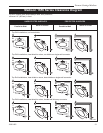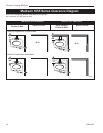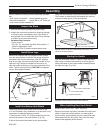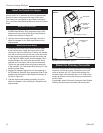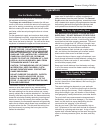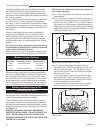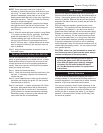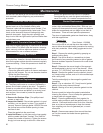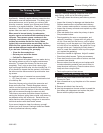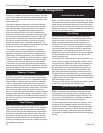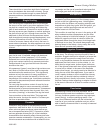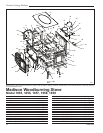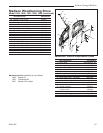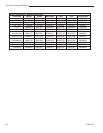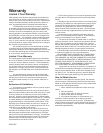
23
Vermont Castings Madison
30001453
There should be no more than eight feet of single-wall
stove pipe between the stove and a chimney. Longer
runs can cool the smoke enough to cause draft and
creosote problems. Use double-wall stove pipe for
longer runs.
Single Venting
Your stove requires a dedicated flue. Do not connect
the stove to a flue used by any other appliance. Chim-
ney draft is a natural form of energy and follows the
path of least resistance. If the stove is vented to a flue
that also serves an open fireplace or another appliance,
the draft will also pull air in through those avenues. The
additional air flow will lower flue temperatures, reduce
draft strength and promote creosote development; over-
all stove performance will suffer. The effect is similar
to that of a vacuum cleaner with a hole in the hose. In
some extreme instances, the other appliance can even
impose a negative draft and result in a dangerous draft
reversal.
Fuel
Even the best stove installation will not perform well if
poor fuel is used. If available, always use hardwood
that has been air-dried (‘seasoned’) 12-18 months.
Softwood burns more rapidly than hardwood and has
a high resin content conducive to creosote production.
Decayed wood of any type has little heat value and
should not be used.
All unseasoned (‘green’) wood has a high moisture con-
tent. Much of its heat value will be used to evaporate
moisture before the wood can burn. This significantly
reduces not only the amount of energy available to
warm your home, but also the intensity of the fire and
temperature of the exhaust gas. Incomplete combustion
and cool flue temperatures promote creosote formation
and weak draft.
You can judge the moisture content of wood by its ap-
pearance and weight or use a commercially available
moisture meter for an exact measurement. Unseasoned
wood will be a third heavier than dry wood. Also, look
for cracks (‘checking’) in the ends of the log that result
from contraction as the wood dries. The longer and
wider the cracks, the dryer the wood is. Purchase your
fuel from a reputable dealer.
Creosote
Creosote is a by-product of low-temperature stove
operations, weak draft or both. It is a tar that results
when unburned gases condense inside the flue sys-
tem at temperatures below 290°F. Creosote is volatile
and can generate chimney fire. All of the installation
characteristics that adversely affect chimney draft also
promote creosote condensation. Consequently, you can
minimize creosote accumulation with an effective chim-
ney design and the use of operational techniques that
encourage good draft and complete combustion.
Backpuffing
Backpuffing is a condition that results when the draft is
too weak to pull flue gases out of the chimney system
as fast as the fire is generating more. Volatile gases
build up within the firebox until reaching a density and
temperature at which they ignite. With this ignition, you
may hear a muffled popping sound and see a bit of
smoke forced out of the air inlets.
This condition is most likely to occur in the spring or fall
when moderate outdoor temperatures and low inten-
sity fires combine to inhibit draft strength. If your stove
backpuffs, open the air inlets to induce a livelier fire
and speed airflow through the stove. Avoid large loads
of firewood at one time. You should always see lively,
dancing flames in the firebox; a lazy, smoky fire is inef-
ficient and will promote draft problems.
Negative Pressure
Good draft also depends on a sufficient supply of air
to the stove. The chimney cannot pull more air than is
available. Sluggish draft can be caused by a house that
is tight enough to prevent the ready flow of air to the
stove, or by competition between the stove and other
appliances that vent indoor air to the outside; i.e., ex-
haust fans for range hoods, clothes dryers, bathroom,
etc. If the chimney draws well when all such equipment
is turned off (or sealed, in the case of the fireplaces
and/or other stoves), you simply need to be attentive in
timing the use of the other appliances. If you need to
crack a nearby window or door to enable the chimney
to pull well, you should install an outside-air intake to
bring combustion air directly to the stove. Consult your
Vermont Castings dealer regarding an adapter to attach
to the stove to connect an air duct for outdoor combus-
tion air.
Conclusion
Woodburning is more an art than a science. Art in-
cludes technique and since installations, homes and
fuel vary, the stove operator must also vary technique,
(mostly timing), to achieve satisfying results. Over
time, you will become familiar with the intricacies and
nuances of your particular installation and you will be
able to identify cause and effect in a variety of seasonal
circumstances.



